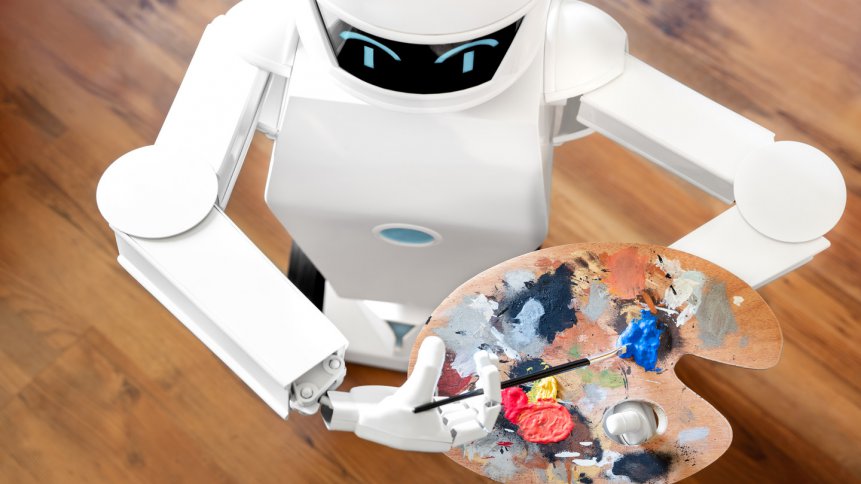AI Art Wins Prize – But Should It Be Allowed?

It’s rare for the Colorado State Fair Fine Arts Competition to make international headlines. But this year, that’s exactly what’s happening, as a result of game designer Jason M. Allen’s win in the emerging artist’s division of the competition’s “digital arts/digitally-manipulated photography” category in August. It’s news because Allen’s work of art was created for the most part not by drawing lines and forms, but by repeatedly refining terms in an AI program called Midjourney.
The AI is one of a handful of such programs that are making news, because when given precise prompts, they learn how to mimic artistic styles throughout the centuries, and to add in elements based on the prompt-phrases, blending them with increasing perfection into the stylistic and content constraints given them by the artist.
READ NEXT

Virtual Influencers, Real Power?
Allen’s win has stoked fury from so-called “real artists,” who dedicated their skills, their eye, their artistic perspective to creating works of art, and who claim that getting an AI to do the creating for you negates the very nature of art.
When Is A Paintbrush Not Just A Paintbrush?
But their anger at Allen’s victory in what was his first ever art competition opens up the whole question of where art begins, and when a tool ceases to be just a tool – particularly when dealing with a technology like AI, which is arguably the equivalent of having a paintbrush that learns how you’d like to be able to paint, and delivers you the results you want, without you having to put the work in to learning how to paint that way.
Midjourney is freely available to use via Discord, and like other AI art generators (the most famous of which is probably DALL-E 2, though that is famously open only to those who have an invite), it works on the principle of iteratively learning what to include in an image and how to render it, based on precise written instructions, and access to images by historic artists and modern ones.
That inclusion of human artists’ work in the training set of Midjourney has already found the software – and the company behind it – in trouble with artists who say it devalues “real artists’” work by allowing them to be used, manipulated, and output in different ways, without necessarily crediting the original artwork or its creator.
The Musical Precedent
There’s a historical precedent for this, in that if a rap artist samples a song, a verse, or even a bassline from another artist’s original work, they either have to credit the original and pay dues to its creator (or the estate of its creator), or they can be sued for using the work without permission and payment.
But visual – and indeed textual – art has always been somewhat looser in its dividing lines of inspiration, homage, plagiarism, and forgery. Anyone can teach themselves to paint “in the style of Van Gogh” – they’re not obliged to credit Van Gogh as a vital component of their own creative process. The influences will either be obvious (to those in the know), or irrelevant, in that stylistic cues are reproduced by the individual artist. Unless they say “This work is by Van Gogh,” and attempt to sell it as such, nobody is going to arrest them or sue them, because the inspiration is processed through their own creative process.
All of which means it’s difficult to rationally make the case that AI like Midjourney is anything more than a tool that would-be artists can use. Absolutely, it removes the necessity to have particular levels of learned skill in rendering an artistic vision from the mind to a canvas through painstaking hours of brush strokes, but it still connects the original creative thoughts of the artist with the finished result – and to get a result like Allen’s prizewinning “Théâtre D’opéra Spatial,” it still takes long hours of refining terms to produce the desired result. In fact, Allen said it had ultimately taken him 80 hours to turn his initial idea of a mashup of Victorian figures and science fiction images into a prizewinning combination of Renaissance stylistic and lighting influences and steampunk figures.
The Potential Pitfalls
Given that both the initial creative impulse to mash particular styles together, the hours of creative refinement it took to generate exactly the right image by feeding in bot commands to Discord, and the final touch-up work using programs like Photoshop and Gigapixel AI, were all performed by Allen, it’s difficult to conclude that – at least as yet – the artist is still the inspired, creative human being, and the AI just the very clever paintbrush that takes the inspiration and renders it in a form that is technically beyond the artist’s ability to produce in any other way.
READ NEXT

Do AI Rappers Spit Electric Offence?
There’s undoubtedly cause for at least distant concern in the idea of letting AI loose in artistic pursuits – there has recently been a case of an AI “virtual rapper” which fell foul of both its machine learning and its inability to filter for cultural appropriation: FN Meka was dropped by its label (Yes, it had gained a label) after inappropriately using the N-word, despite the rhymes being actually spoken by a black man, and the virtual rapper’s avatar being coded as black. The AI had learned what was appropriate for leading rap artists and mimicked it, without in any sense being able to share the cultural history that confers permission to use particular words, or speak authentically about experiences.
Art Is As Art Does
But the repeated human input guiding the process in AI like Midjourney seems to negate the concerns of cultural appropriation – or at least to make them obvious if and when they occur.
Certainly, the judges at the Colorado State Fair Fine Arts Competition seemed unperturbed by Allen’s use of Midjourney. While he declared his use of the AI when he submitted his work, so as to be clear about the creative process, neither of the judges were entirely aware when they awarded him his $300 of quite how Midjourney worked. That said, they have subsequently affirmed that had they been aware, it would have made no difference – they would still have awarded Allen first prize, because of the power of the eventual image.
Old Arguments, New Technology
Decades ago, there was an equal outcry when programs like Photoshop first emerged and the very idea of “electronic art” was derided by “real artists” who felt that it made the process too easy and lessened the skill required to call oneself an artist. In the age of AI, such gatekeeping feels like the rehearsal of old arguments about a “uniquely human” skillset. When, as is equally inevitable, AIs begin creating independent art, novels, poetry and music, the real issue will be that our society is not quite ready to acknowledge how we as humans arrive at our creative impulses and endeavors.
The question of “Yes, but is it art?” is already being asked in the area of 3D printing. Without a 3D printer, someone might create a sculpture over months. With one, the same sculpture can be produced in days, or even hours. And then recreated, time and time again. Is it still art? Yes – but art is just the name we have traditionally give to programming that’s run through the computer of our brain and output through our hands.
The tools are changing, and in time it might well be true that AI can more regularly create masterpieces than any single human. What seems clear is that we couldn’t stop it now, even if we wanted to. And when AI is helping artists create pieces that deliver joy to an audience, the evidence is all too slim that we do.








